古典音乐英文介绍
- 格式:pptx
- 大小:2.31 MB
- 文档页数:13
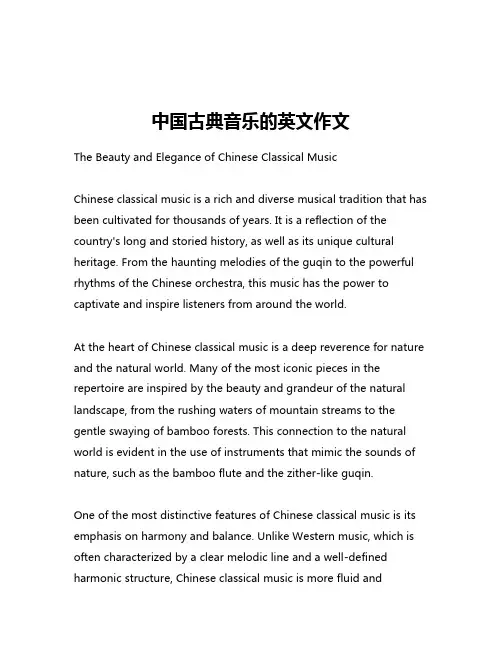
中国古典音乐的英文作文The Beauty and Elegance of Chinese Classical MusicChinese classical music is a rich and diverse musical tradition that has been cultivated for thousands of years. It is a reflection of the country's long and storied history, as well as its unique cultural heritage. From the haunting melodies of the guqin to the powerful rhythms of the Chinese orchestra, this music has the power to captivate and inspire listeners from around the world.At the heart of Chinese classical music is a deep reverence for nature and the natural world. Many of the most iconic pieces in the repertoire are inspired by the beauty and grandeur of the natural landscape, from the rushing waters of mountain streams to the gentle swaying of bamboo forests. This connection to the natural world is evident in the use of instruments that mimic the sounds of nature, such as the bamboo flute and the zither-like guqin.One of the most distinctive features of Chinese classical music is its emphasis on harmony and balance. Unlike Western music, which is often characterized by a clear melodic line and a well-defined harmonic structure, Chinese classical music is more fluid andimprovisational. The musicians often use techniques like pitch bending and microtonal variations to create a sense of subtle and ever-changing harmonies.This emphasis on harmony and balance is also reflected in the structure of Chinese classical music. Many pieces are based on a series of interconnected melodic phrases, rather than a single, dominant melody. This allows the music to flow and evolve in a more organic and natural way, with each instrument or voice contributing to the overall tapestry of sound.Another key aspect of Chinese classical music is its deep connection to the country's rich literary and philosophical traditions. Many of the most famous pieces in the repertoire are based on classic Chinese poems or stories, and the musicians often draw on the imagery and symbolism of these works to inform their musical interpretations.For example, the guqin piece "Flowing Water" is inspired by the famous poem of the same name, which describes the gentle flow of a mountain stream. The musician's task is to capture the essence of this natural scene through the subtle and evocative use of the instrument's strings and resonances.Similarly, the Chinese orchestra piece "Autumn Moon on a Calm Lake" is inspired by the serene and contemplative mood of a moonlitlake in autumn. The musicians use a variety of instruments, including the erhu (a two-stringed fiddle) and the pipa (a four-stringed lute), to create a haunting and atmospheric soundscape that evokes the beauty and tranquility of the natural world.In addition to its connection to literature and philosophy, Chinese classical music is also deeply rooted in the country's rich cultural traditions. Many of the most important pieces in the repertoire are associated with specific rituals or ceremonies, such as the performance of the guqin during Confucian ceremonies or the use of the Chinese orchestra in imperial court music.This deep cultural connection has helped to ensure the ongoing vitality and relevance of Chinese classical music, even in the face of rapid social and technological change. Today, this music continues to be studied and performed by musicians and scholars around the world, who are drawn to its unique blend of technical virtuosity, emotional expressiveness, and cultural significance.Despite the many challenges and changes that have shaped the course of Chinese history, the enduring power and beauty of Chinese classical music remains a testament to the resilience and creativity of the Chinese people. Whether you are a seasoned listener or a newcomer to this rich musical tradition, there is much to discoverand appreciate in the timeless melodies and harmonies of Chinese classical music.。

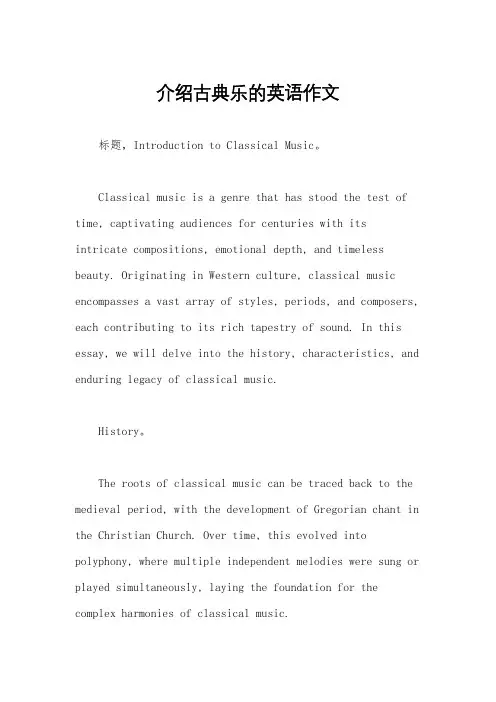
介绍古典乐的英语作文标题,Introduction to Classical Music。
Classical music is a genre that has stood the test of time, captivating audiences for centuries with itsintricate compositions, emotional depth, and timeless beauty. Originating in Western culture, classical music encompasses a vast array of styles, periods, and composers, each contributing to its rich tapestry of sound. In this essay, we will delve into the history, characteristics, and enduring legacy of classical music.History。
The roots of classical music can be traced back to the medieval period, with the development of Gregorian chant in the Christian Church. Over time, this evolved into polyphony, where multiple independent melodies were sung or played simultaneously, laying the foundation for the complex harmonies of classical music.The Baroque period, spanning roughly from the late 16th to the early 18th century, saw the emergence of renowned composers such as Johann Sebastian Bach, George Frideric Handel, and Antonio Vivaldi. This era was characterized by elaborate ornamentation, intricate counterpoint, and the invention of new musical forms such as the fugue and concerto.The Classical period, which followed the Baroque, witnessed the rise of composers like Wolfgang Amadeus Mozart, Ludwig van Beethoven, and Franz Joseph Haydn. Known for its clarity, balance, and emotional restraint,Classical music favored symphonies, sonatas, and string quartets, showcasing a shift towards more structured and formal compositions.The Romantic period, spanning the 19th century, brought forth a wave of emotional intensity, virtuosity, and experimentation in classical music. Composers such asLudwig van Beethoven, Pyotr Ilyich Tchaikovsky, and Johannes Brahms pushed the boundaries of musical expression,exploring themes of love, nature, and the human conditionin their compositions.The 20th century witnessed further innovation and diversity in classical music, with composers like Igor Stravinsky, Arnold Schoenberg, and Claude Debussy exploring new harmonic languages, rhythmic complexities, and avant-garde techniques. From the lush melodies of the Impressionists to the dissonant sounds of the modernists, classical music continued to evolve and adapt to the changing cultural landscape.Characteristics。
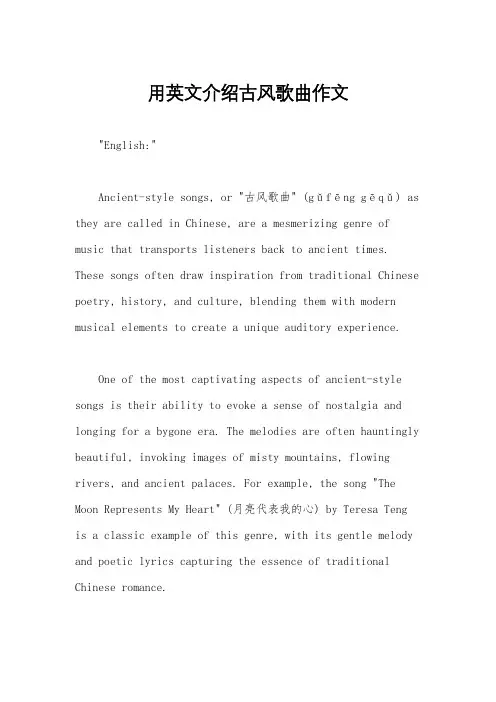
用英文介绍古风歌曲作文"English:"Ancient-style songs, or "古风歌曲" (gǔfēng gēqǔ) as they are called in Chinese, are a mesmerizing genre of music that transports listeners back to ancient times. These songs often draw inspiration from traditional Chinese poetry, history, and culture, blending them with modern musical elements to create a unique auditory experience.One of the most captivating aspects of ancient-style songs is their ability to evoke a sense of nostalgia and longing for a bygone era. The melodies are often hauntingly beautiful, invoking images of misty mountains, flowing rivers, and ancient palaces. For example, the song "The Moon Represents My Heart" (月亮代表我的心) by Teresa Teng is a classic example of this genre, with its gentle melody and poetic lyrics capturing the essence of traditional Chinese romance.Another defining feature of ancient-style songs istheir emphasis on storytelling. Many of these songs tell tales of love, heroism, and adventure, drawing listeners into rich narratives that unfold with each verse. Take, for instance, the song "Jasmine Flower" (茉莉花), which tells the story of a young woman pining for her lover amidst the fragrant blooms of jasmine. The poignant lyrics and emotive melody make it a timeless favorite among fans of ancient-style music.Furthermore, ancient-style songs often incorporate traditional Chinese instruments such as the guzheng, pipa, and erhu, adding depth and authenticity to the music. These instruments not only lend a distinctively Chinese flavor to the songs but also contribute to their evocative power. When combined with modern production techniques, the result is a seamless fusion of old and new, tradition and innovation.In addition to their musical appeal, ancient-style songs also serve as a window into Chinese culture and history. Through the themes explored in these songs,listeners can gain insights into traditional values, beliefs, and customs. For example, songs like "The Song of Four Seasons" (四季歌) celebrate the beauty of nature and the passage of time, reflecting the deep reverence for harmony between humanity and the natural world in Chinese philosophy.Overall, ancient-style songs offer a captivating blend of nostalgia, storytelling, and cultural richness that continues to enchant listeners around the world. Whether you're drawn to the haunting melodies, the poetic lyrics, or the evocative blend of traditional and modern elements, there's something undeniably magical about the timeless allure of 古风歌曲."中文,"古风歌曲是一种令人陶醉的音乐流派,将听众带回古代。


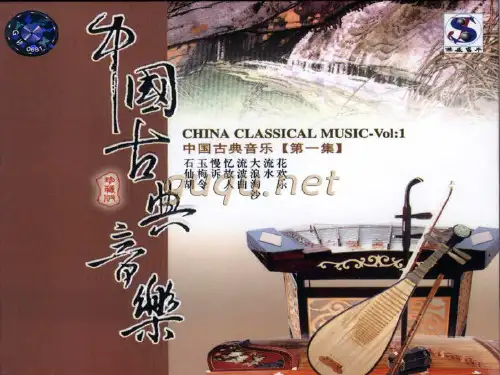
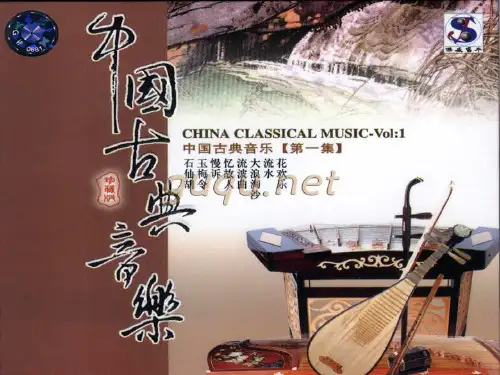
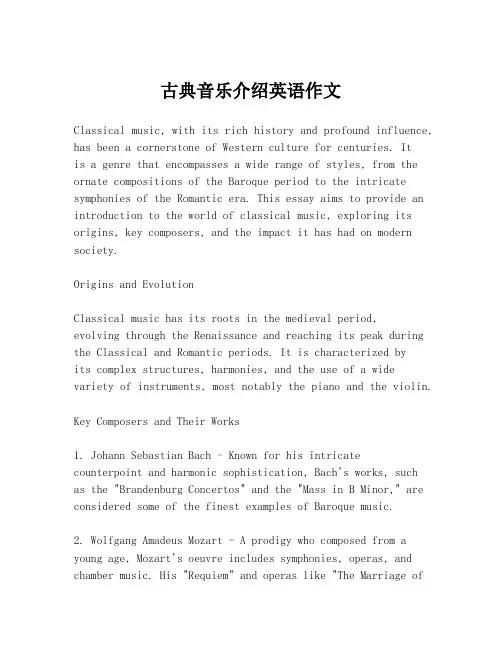
古典音乐介绍英语作文Classical music, with its rich history and profound influence, has been a cornerstone of Western culture for centuries. Itis a genre that encompasses a wide range of styles, from the ornate compositions of the Baroque period to the intricate symphonies of the Romantic era. This essay aims to provide an introduction to the world of classical music, exploring its origins, key composers, and the impact it has had on modern society.Origins and EvolutionClassical music has its roots in the medieval period,evolving through the Renaissance and reaching its peak during the Classical and Romantic periods. It is characterized byits complex structures, harmonies, and the use of a wide variety of instruments, most notably the piano and the violin.Key Composers and Their Works1. Johann Sebastian Bach - Known for his intricatecounterpoint and harmonic sophistication, Bach's works, suchas the "Brandenburg Concertos" and the "Mass in B Minor," are considered some of the finest examples of Baroque music.2. Wolfgang Amadeus Mozart - A prodigy who composed from a young age, Mozart's oeuvre includes symphonies, operas, and chamber music. His "Requiem" and operas like "The Marriage ofFigaro" are still performed worldwide.3. Ludwig van Beethoven - Beethoven's music marked a transition from the Classical to the Romantic period. His "Symphony No. 9" and "Moonlight Sonata" are iconic piecesthat continue to inspire musicians and listeners alike.4. Pyotr Ilyich Tchaikovsky - A leading composer of the Romantic period, Tchaikovsky's "Swan Lake" and "1812 Overture" are testaments to his emotive and expressive style.Instruments and OrchestrasThe classical music ensemble typically includes a range of string, woodwind, brass, and percussion instruments. The modern symphony orchestra, which can number over a hundred musicians, is the largest ensemble in the genre and is capable of producing a vast array of sounds and dynamics.Impact on Modern SocietyClassical music has permeated various aspects of modern culture. It is not only performed in concert halls but also featured in films, commercials, and even video games. The study of classical music has been shown to enhance cognitive abilities and is often included in educational curriculums.ConclusionClassical music is a testament to the human capacity for creativity and expression. It has the power to evoke deepemotions and has stood the test of time, remaining relevant and beloved by audiences around the world. As we continue to explore and appreciate this vast and diverse genre, we gain a deeper understanding of our cultural heritage and the universal language of music.。
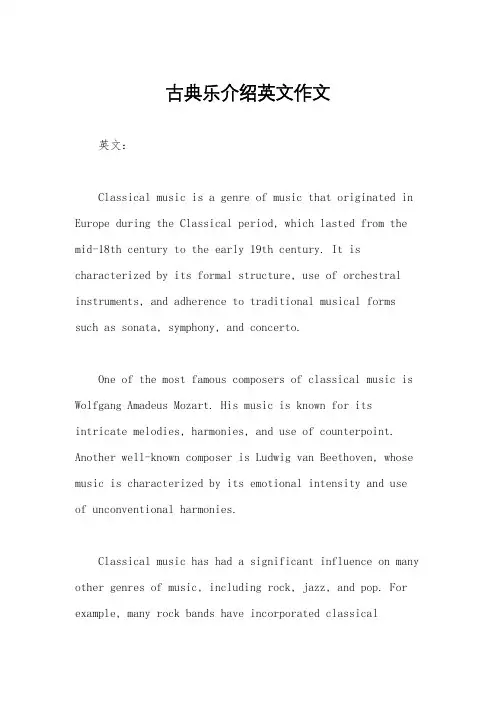
古典乐介绍英文作文英文:Classical music is a genre of music that originated in Europe during the Classical period, which lasted from the mid-18th century to the early 19th century. It is characterized by its formal structure, use of orchestral instruments, and adherence to traditional musical forms such as sonata, symphony, and concerto.One of the most famous composers of classical music is Wolfgang Amadeus Mozart. His music is known for itsintricate melodies, harmonies, and use of counterpoint. Another well-known composer is Ludwig van Beethoven, whose music is characterized by its emotional intensity and use of unconventional harmonies.Classical music has had a significant influence on many other genres of music, including rock, jazz, and pop. For example, many rock bands have incorporated classicalelements into their music, such as the use of orchestral instruments or classical chord progressions.In addition to its musical influence, classical music also has a rich cultural history. Many famous classical works were commissioned by wealthy patrons, such as the Hapsburgs in Austria or the Medici family in Italy. These works were often performed at elaborate royal or aristocratic events, such as balls or operas.Overall, classical music is a genre that has stood the test of time and continues to inspire and influence musicians and music lovers around the world.中文:古典音乐是一种起源于欧洲的音乐流派,始于18世纪中期,持续到19世纪初。

学古典音乐英文作文Classical Music: A Journey into Timeless Beauty。
Classical music, with its intricate melodies, eloquent harmonies, and evocative rhythms, has captivated the human spirit for centuries. From the grand operas of the Baroque Era to the groundbreaking symphonies of the Romantic period, classical music continues to inspire awe and ignite the imagination.A History of Musical Evolution。
The roots of classical music can be traced back to the ancient Greeks, who believed that music possessed the power to heal and purify. During the Middle Ages, Gregorian chant, a form of monophonic liturgical music, dominated themusical landscape. The Renaissance witnessed the emergenceof polyphony, where multiple independent melodies were woven together to create a complex and textured soundscape.The Baroque and Classical Eras。
古典音乐特点英语作文英文回答:Classical music, a genre dating back centuries, is characterized by its complexity, sophistication, and enduring beauty. Its distinctive features set it apart from other musical styles and have captivated audiences worldwide for generations.Composition:Classical music is typically composed for orchestras or smaller ensembles, featuring a wide range of instruments, including strings, woodwinds, brass, and percussion. Composers employ complex arrangements and harmonies, often based on classical forms such as sonatas, symphonies, and concertos.Melody and Harmony:Classical music is renowned for its intricate melodies and sophisticated harmonies. Melodies often feature soaring lines, graceful contours, and memorable motifs. Harmonic progressions are often complex and include unexpected resolutions, creating a sense of tension and release.Form and Structure:Classical music adheres to predefined forms and structures, providing a sense of order and coherence. Sonatas typically follow a three-movement form (exposition-development-recapitulation), while symphonies can have multiple movements with contrasting tempos and moods.Dynamics and Articulation:Classical music is characterized by a wide range of dynamics and articulation. Composers use dynamics (volume) to create crescendos, decrescendos, and sudden accents, while articulation (manner of playing) encompasses techniques such as legato, staccato, and trills.Ornamentation and Embellishment:Ornamentation and embellishment are common features in classical music. Composers incorporate trills, grace notes, slurs, and other embellishments to enhance the beauty and complexity of the music.Historical Context:Classical music emerged during the Baroque period(1600-1750), with composers such as Bach, Handel, and Vivaldi. It continued to evolve through the Classicalperiod (1750-1820), characterized by greater elegance and sophistication, with composers such as Mozart and Beethoven. The Romantic period (1820-1910) saw a shift towards more expressive and emotional music, with composers such as Chopin, Brahms, and Tchaikovsky.Modern Influence:Classical music has had a profound influence on subsequent musical styles, including jazz, rock, and pop.Contemporary composers continue to draw inspiration from classical traditions, incorporating elements of complexity, form, and instrumentation into their own works.中文回答:古典音乐的特点。
古典音乐英文介绍作文高中英文,Classical music, also known as "art music," is a genre of music that has its roots in Western culture. It is often considered to be more complex and sophisticated than other forms of music, such as pop or rock. Classical music is typically composed for large orchestras, with instruments such as violins, cellos, flutes, and trumpets. One of the defining characteristics of classical music is its use of complex harmonies and melodies, as well as its emphasis on structure and form.Classical music has a rich history and has been around for centuries. It has evolved through various periods, such as the Baroque, Classical, Romantic, and Modern periods, each of which has its own distinct style and characteristics. For example, the Baroque period is known for its ornate and elaborate compositions, while the Romantic period is characterized by its emotional and expressive melodies.One of the most famous classical composers is Ludwig van Beethoven, who is known for his powerful and emotional compositions. His Symphony No. 9, also known as the "Choral Symphony," is a prime example of the grandeur and complexity of classical music. Another iconic composer is Wolfgang Amadeus Mozart, whose compositions are known for their elegance and beauty.In addition to orchestral music, classical music also includes solo and chamber music, such as piano sonatas and string quartets. These smaller ensembles allow for more intimate and nuanced performances, showcasing the technical skill and artistry of the musicians.Classical music has had a significant influence on modern music and continues to be appreciated by audiences around the world. Its timeless beauty and complexity have made it a beloved genre for music enthusiasts and performers alike.中文,古典音乐,也被称为“艺术音乐”,是一种源自西方文化的音乐流派。
介绍西方传统音乐英语作文带翻译It can be said that the time, place and people have contributed to the prosperity of Vienna classical music school. So when did the classical period begin and end? Generally speaking, the death of J. S. Bach in 1750 marked the end of the Baroque era and the beginning of the classical period; The death of Beethoven in 1827 marked the end of the classical period. In less than a hundred years, the classical style became the criterion of art and the yardstick of aesthetics at that time.Western classical music is divided into pre classical and Vienna classical.Romantic period. After Beethoven, Western classical music entered the romantic period. Romantic musicians either pay more attention to the expression of personal emotions (such as Schubert and Chopin), or are fascinated by the expression of strong drama in literary works (such as Wagner and richardstrauss). They keep breaking the rules of classicism just to make people more moved by the unique content they express. At this time, many music structureshave lost the rigor of the classical period, but they are also more flexible.The melody of many music is greatly enhanced, and the handling of harmony is also changeable. Therefore, most of these music have more subtle changes in emotional color. Needless to say, the scope of performance is greatly broadened compared with that in the classical period. Symphonic poetry is the product of the romantic period. It was first created by Liszt and carried forward by richardstraw and others. It is usually related to great literary works or folk stories. During the romantic period, more free piano music also appeared. In this regard, the well-known "piano poet" Chopin and "king of the piano" Liszt and others undoubtedly contributed a lot. Symphonies that were already perfect in the classical period have been further developed, and many magnificent works have appeared, which will be discussed in detail below.representative figureThere are countless musicians in the romantic period. As an "Introduction" lecture, I only select a few particularly important composers here to give you a brief introduction. If you want to knowmore composers or more detailed introductions, you can only wrongly go online (there are many such books in general music bookstores)!ChopinIt is estimated that everyone is familiar with Chopin, because several domestic piano masters like to play Chopin. It is not difficult to understand that so much ethereal and elegant atmosphere in Chopin's piano music has something in common with Chinese culture. Chopin is known as a "piano poet", which anyone who has heard his music has to admit. He almost only writes for the piano, so he can give full play to the lyricism of the piano.As a polish, the national characteristics of his music are also obvious. His nocturnes, Waltzes, Polonaises, ballads, scherzos, etc. have long been known to everyone. His 24 preludes are considered to be the motivation for each capital to develop into a huge symphony. His two piano concertos with similar styles before the age of 20 were considered by music critics as seriously neglecting the performance of the band (like Paganini's Violin Concerto?), But in terms of the emotional expression of music, it is undoubtedly avery beautiful work, which appropriately expresses the sweetness and sadness of youth.SchumannSchumann finally got psychotic, and many people call him the embodiment of romantic spirit. From this, we can also know that it is not necessarily a good thing to indulge in personal passion. Most of his music is lyrical, poetic and sometimes intense. He has composed four symphonies, none of which is as famous as those mentioned above. Schumann's most frequently mentioned works are the piano suite scenes of childhood, piano Fantasia in C major, Carnival and so on. His Piano Concerto in a minor is also a good work. In addition, Schumann is also a master of art songs, and has composed a joint song "the poet's love" and so on.LisztAs mentioned earlier, it was Liszt who created the genre of "symphonic poetry", and he himself wrote many symphonic poems, including Tasso, the prelude showing that "life is just a prelude to death", majiepa showing the deeds of the hero majiepa, and so on. Liszt's piano performance is also extraordinary. Some people saythat Liszt failed to give full play to his composing talent in order to satisfy his vanity as a performer. However, his achievements are considerable. The 19 highly skilled Hungarian Rhapsody (not to be confused with Brahms' 21 Hungarian Dances) set a good example for future generations in terms of playing skills and the expressiveness of such instruments as the piano. There are also his two Piano Concertos, Faust Symphony and Dante Symphony, which can also be called masterpieces.SchubertSchubert was undoubtedly a heavyweight in the romantic period. As we all know, he is the "king of songs" and has made countless excellent art songs that have a great impact on future generations. He also wrote nine symphonies (nine more!), The last two are extraordinary works. The ninth is called the "great symphony" because of its noble temperament and huge structure. The eighth is called "unfinished" if it is not finished, but it is a classic in the symphony treasure house. Its sad and lonely atmosphere and exquisite inner emotional expression typically show the characteristics of romantic music. Schubert also performed well inchamber music. His "Trout Quintet" and "death and the girl" String Quartet are all warm and moving works, which are also popular in record making. He also wrote a number of warm and moving piano sketches, such as moments of music and impromptu.berliozBerlioz first told the story with a symphony. His symphony of fantasy describes his love fantasy for an actress. He said that these fantasies were caused by attempted suicide by taking medicine. There were fields, dances, guillotines and ghosts. It was really fun. He also used the writing method of "fixed music thinking" for the first time in this symphony, that is, a theme representing the woman and its variations are used throughout the whole symphony from beginning to end, which not only facilitates the story telling, but also makes the movements of the work obtain a strong unity. His technique had a great influence on later composers such as Liszt. Berlioz's other important works include the orchestral Carnival of Rome and the dramatic Symphony Romeo and Juliet.MendelssohnMendelssohn is also a short-lived genius. His musicalachievements are not to mention, but for the sake of digging out Bach, who was unknown at that time. We should also be grateful to him. Mendelssohn was born in a noble family with a superior life. He received a good education since childhood and even had his own symphony orchestra. His music is just like his identity, noble, elegant, gorgeous, almost no loopholes. Naturally, in such a living environment, he does not have strong passion. It is estimated that he has not experienced the feelings of loneliness, sadness and anger in his lifetime. These are what his music lacks. Therefore, some music critics say that he is perfect but not profound. His violin concerto is a rare song of youth, so it can be listed in the "four major associations" without being weak. His five symphonies are almost perfect in terms of composition, among which "Scotland" and "Italy" are the tracks that should not be listened to by musicians. The music he wrote for the drama a midsummer night's dream also reflects his musical genius. However, his piano sketch "Songs without words" series is considered to be no worse than Chopin in terms of lyricism.可以这么说,天时、地利、人和造就了维也纳古典乐派的兴盛。